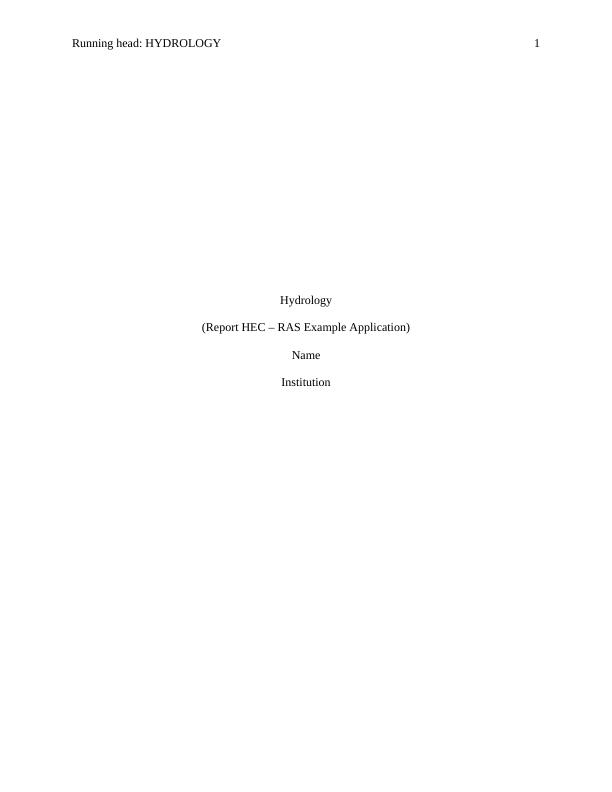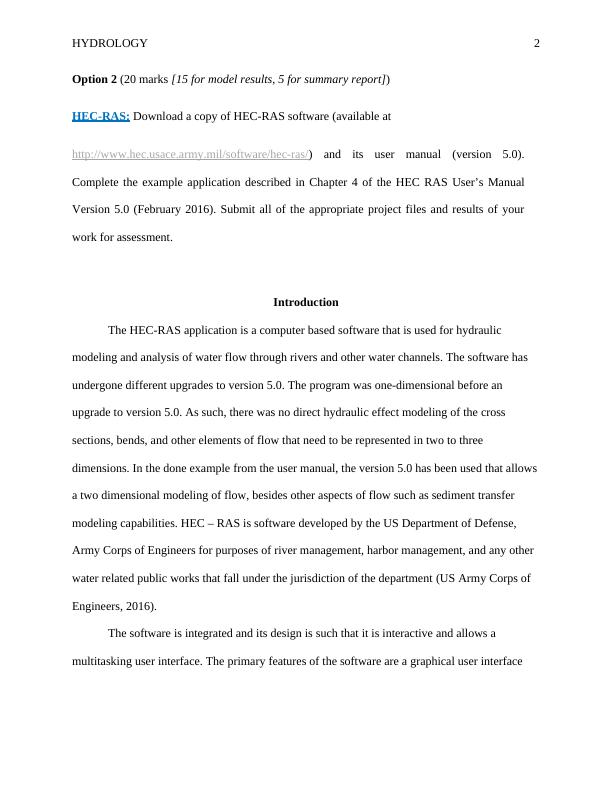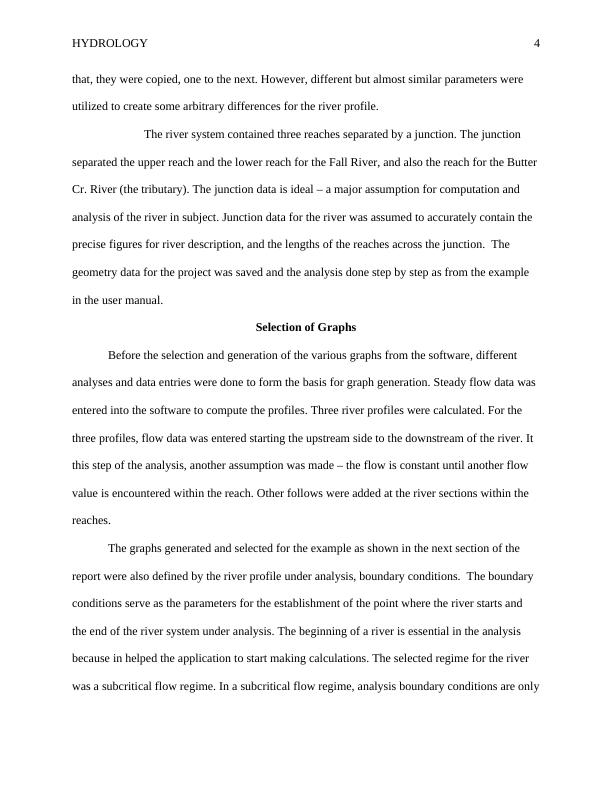Hydrology: Report HEC – RAS Example Application
Added on 2023-06-11
12 Pages1769 Words111 Views
Running head: HYDROLOGY 1
Hydrology
(Report HEC – RAS Example Application)
Name
Institution
Hydrology
(Report HEC – RAS Example Application)
Name
Institution

HYDROLOGY 2
Option 2 (20 marks [15 for model results, 5 for summary report])
HEC-RAS: Download a copy of HEC-RAS software (available at
http://www.hec.usace.army.mil/software/hec-ras/) and its user manual (version 5.0).
Complete the example application described in Chapter 4 of the HEC RAS User’s Manual
Version 5.0 (February 2016). Submit all of the appropriate project files and results of your
work for assessment.
Introduction
The HEC-RAS application is a computer based software that is used for hydraulic
modeling and analysis of water flow through rivers and other water channels. The software has
undergone different upgrades to version 5.0. The program was one-dimensional before an
upgrade to version 5.0. As such, there was no direct hydraulic effect modeling of the cross
sections, bends, and other elements of flow that need to be represented in two to three
dimensions. In the done example from the user manual, the version 5.0 has been used that allows
a two dimensional modeling of flow, besides other aspects of flow such as sediment transfer
modeling capabilities. HEC – RAS is software developed by the US Department of Defense,
Army Corps of Engineers for purposes of river management, harbor management, and any other
water related public works that fall under the jurisdiction of the department (US Army Corps of
Engineers, 2016).
The software is integrated and its design is such that it is interactive and allows a
multitasking user interface. The primary features of the software are a graphical user interface
Option 2 (20 marks [15 for model results, 5 for summary report])
HEC-RAS: Download a copy of HEC-RAS software (available at
http://www.hec.usace.army.mil/software/hec-ras/) and its user manual (version 5.0).
Complete the example application described in Chapter 4 of the HEC RAS User’s Manual
Version 5.0 (February 2016). Submit all of the appropriate project files and results of your
work for assessment.
Introduction
The HEC-RAS application is a computer based software that is used for hydraulic
modeling and analysis of water flow through rivers and other water channels. The software has
undergone different upgrades to version 5.0. The program was one-dimensional before an
upgrade to version 5.0. As such, there was no direct hydraulic effect modeling of the cross
sections, bends, and other elements of flow that need to be represented in two to three
dimensions. In the done example from the user manual, the version 5.0 has been used that allows
a two dimensional modeling of flow, besides other aspects of flow such as sediment transfer
modeling capabilities. HEC – RAS is software developed by the US Department of Defense,
Army Corps of Engineers for purposes of river management, harbor management, and any other
water related public works that fall under the jurisdiction of the department (US Army Corps of
Engineers, 2016).
The software is integrated and its design is such that it is interactive and allows a
multitasking user interface. The primary features of the software are a graphical user interface

HYDROLOGY 3
(GUI), separate analysis components, data storage components, management of data elements
and, graphics and reporting facilities.
The river analysis components in HEC – RAS include: (1) water quality analysis. (2)
unsteady flow simulations (both in one dimensional and two dimensional), (3) steady flow water
surface profile computations and (4) Quasi unsteady or fully unsteady flow movable boundary
sediment transport computations. All the primary elements of the software use the same
geometric data representation and geometric and hydraulic computations routines that are
similar.
In the example done from Chapter four of the user manual, the following are the process
were done: staring a New project, entering geometric data, entering steady flow data, performing
the hydraulic calculations, viewing results, and existing the program.
Summary of the Assumptions Made
After starting a new project, various assumptions were made during project processing
and execution. The example done in the application is an imaginary example, and that no data
was obtained from any field for analysis.
The first assumption made is that the river to be analyzed exists and it is a two river
hydraulic system, i.e. a three hydraulic reaches system as it is depicted in the project files. In
development of this model, the next major assumption made is that the river profile has
georeferences. However, these georeferences are not real, they do not exist. As such, an
imaginary georeferenced background map was selected, or was brought into the application.
Another major assumption made during project execution is the cross sections for the
river system actually exists and the parameters given for the river system are actual parameters.
The cross sections were also assumed to be uniform throughout the river profiles, and because of
(GUI), separate analysis components, data storage components, management of data elements
and, graphics and reporting facilities.
The river analysis components in HEC – RAS include: (1) water quality analysis. (2)
unsteady flow simulations (both in one dimensional and two dimensional), (3) steady flow water
surface profile computations and (4) Quasi unsteady or fully unsteady flow movable boundary
sediment transport computations. All the primary elements of the software use the same
geometric data representation and geometric and hydraulic computations routines that are
similar.
In the example done from Chapter four of the user manual, the following are the process
were done: staring a New project, entering geometric data, entering steady flow data, performing
the hydraulic calculations, viewing results, and existing the program.
Summary of the Assumptions Made
After starting a new project, various assumptions were made during project processing
and execution. The example done in the application is an imaginary example, and that no data
was obtained from any field for analysis.
The first assumption made is that the river to be analyzed exists and it is a two river
hydraulic system, i.e. a three hydraulic reaches system as it is depicted in the project files. In
development of this model, the next major assumption made is that the river profile has
georeferences. However, these georeferences are not real, they do not exist. As such, an
imaginary georeferenced background map was selected, or was brought into the application.
Another major assumption made during project execution is the cross sections for the
river system actually exists and the parameters given for the river system are actual parameters.
The cross sections were also assumed to be uniform throughout the river profiles, and because of

HYDROLOGY 4
that, they were copied, one to the next. However, different but almost similar parameters were
utilized to create some arbitrary differences for the river profile.
The river system contained three reaches separated by a junction. The junction
separated the upper reach and the lower reach for the Fall River, and also the reach for the Butter
Cr. River (the tributary). The junction data is ideal – a major assumption for computation and
analysis of the river in subject. Junction data for the river was assumed to accurately contain the
precise figures for river description, and the lengths of the reaches across the junction. The
geometry data for the project was saved and the analysis done step by step as from the example
in the user manual.
Selection of Graphs
Before the selection and generation of the various graphs from the software, different
analyses and data entries were done to form the basis for graph generation. Steady flow data was
entered into the software to compute the profiles. Three river profiles were calculated. For the
three profiles, flow data was entered starting the upstream side to the downstream of the river. It
this step of the analysis, another assumption was made – the flow is constant until another flow
value is encountered within the reach. Other follows were added at the river sections within the
reaches.
The graphs generated and selected for the example as shown in the next section of the
report were also defined by the river profile under analysis, boundary conditions. The boundary
conditions serve as the parameters for the establishment of the point where the river starts and
the end of the river system under analysis. The beginning of a river is essential in the analysis
because in helped the application to start making calculations. The selected regime for the river
was a subcritical flow regime. In a subcritical flow regime, analysis boundary conditions are only
that, they were copied, one to the next. However, different but almost similar parameters were
utilized to create some arbitrary differences for the river profile.
The river system contained three reaches separated by a junction. The junction
separated the upper reach and the lower reach for the Fall River, and also the reach for the Butter
Cr. River (the tributary). The junction data is ideal – a major assumption for computation and
analysis of the river in subject. Junction data for the river was assumed to accurately contain the
precise figures for river description, and the lengths of the reaches across the junction. The
geometry data for the project was saved and the analysis done step by step as from the example
in the user manual.
Selection of Graphs
Before the selection and generation of the various graphs from the software, different
analyses and data entries were done to form the basis for graph generation. Steady flow data was
entered into the software to compute the profiles. Three river profiles were calculated. For the
three profiles, flow data was entered starting the upstream side to the downstream of the river. It
this step of the analysis, another assumption was made – the flow is constant until another flow
value is encountered within the reach. Other follows were added at the river sections within the
reaches.
The graphs generated and selected for the example as shown in the next section of the
report were also defined by the river profile under analysis, boundary conditions. The boundary
conditions serve as the parameters for the establishment of the point where the river starts and
the end of the river system under analysis. The beginning of a river is essential in the analysis
because in helped the application to start making calculations. The selected regime for the river
was a subcritical flow regime. In a subcritical flow regime, analysis boundary conditions are only

End of preview
Want to access all the pages? Upload your documents or become a member.
